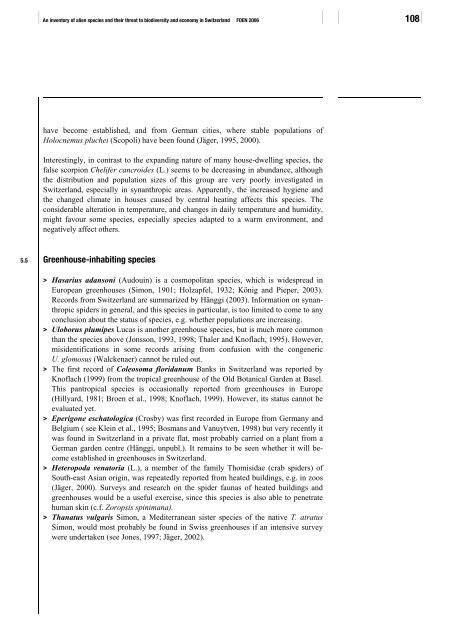Invasive alien species in Switzerland - Schweizer ...
Invasive alien species in Switzerland - Schweizer ...
Invasive alien species in Switzerland - Schweizer ...
You also want an ePaper? Increase the reach of your titles
YUMPU automatically turns print PDFs into web optimized ePapers that Google loves.
An <strong>in</strong>ventory of <strong>alien</strong> <strong>species</strong> and their threat to biodiversity and economy <strong>in</strong> <strong>Switzerland</strong> FOEN 2006 108<br />
have become established, and from German cities, where stable populations of<br />
Holocnemus pluchei (Scopoli) have been found (Jäger, 1995, 2000).<br />
Interest<strong>in</strong>gly, <strong>in</strong> contrast to the expand<strong>in</strong>g nature of many house-dwell<strong>in</strong>g <strong>species</strong>, the<br />
false scorpion Chelifer cancroides (L.) seems to be decreas<strong>in</strong>g <strong>in</strong> abundance, although<br />
the distribution and population sizes of this group are very poorly <strong>in</strong>vestigated <strong>in</strong><br />
<strong>Switzerland</strong>, especially <strong>in</strong> synanthropic areas. Apparently, the <strong>in</strong>creased hygiene and<br />
the changed climate <strong>in</strong> houses caused by central heat<strong>in</strong>g affects this <strong>species</strong>. The<br />
considerable alteration <strong>in</strong> temperature, and changes <strong>in</strong> daily temperature and humidity,<br />
might favour some <strong>species</strong>, especially <strong>species</strong> adapted to a warm environment, and<br />
negatively affect others.<br />
5.5 Greenhouse-<strong>in</strong>habit<strong>in</strong>g <strong>species</strong><br />
> Hasarius adansoni (Audou<strong>in</strong>) is a cosmopolitan <strong>species</strong>, which is widespread <strong>in</strong><br />
European greenhouses (Simon, 1901; Holzapfel, 1932; König and Pieper, 2003).<br />
Records from <strong>Switzerland</strong> are summarized by Hänggi (2003). Information on synanthropic<br />
spiders <strong>in</strong> general, and this <strong>species</strong> <strong>in</strong> particular, is too limited to come to any<br />
conclusion about the status of <strong>species</strong>, e.g. whether populations are <strong>in</strong>creas<strong>in</strong>g.<br />
> Uloborus plumipes Lucas is another greenhouse <strong>species</strong>, but is much more common<br />
than the <strong>species</strong> above (Jonsson, 1993, 1998; Thaler and Knoflach, 1995). However,<br />
misidentifications <strong>in</strong> some records aris<strong>in</strong>g from confusion with the congeneric<br />
U. glomosus (Walckenaer) cannot be ruled out.<br />
> The first record of Coleosoma floridanum Banks <strong>in</strong> <strong>Switzerland</strong> was reported by<br />
Knoflach (1999) from the tropical greenhouse of the Old Botanical Garden at Basel.<br />
This pantropical <strong>species</strong> is occasionally reported from greenhouses <strong>in</strong> Europe<br />
(Hillyard, 1981; Broen et al., 1998; Knoflach, 1999). However, its status cannot be<br />
evaluated yet.<br />
> Eperigone eschatologica (Crosby) was first recorded <strong>in</strong> Europe from Germany and<br />
Belgium ( see Kle<strong>in</strong> et al., 1995; Bosmans and Vanuytven, 1998) but very recently it<br />
was found <strong>in</strong> <strong>Switzerland</strong> <strong>in</strong> a private flat, most probably carried on a plant from a<br />
German garden centre (Hänggi, unpubl.). It rema<strong>in</strong>s to be seen whether it will become<br />
established <strong>in</strong> greenhouses <strong>in</strong> <strong>Switzerland</strong>.<br />
> Heteropoda venatoria (L.), a member of the family Thomisidae (crab spiders) of<br />
South-east Asian orig<strong>in</strong>, was repeatedly reported from heated build<strong>in</strong>gs, e.g. <strong>in</strong> zoos<br />
(Jäger, 2000). Surveys and research on the spider faunas of heated build<strong>in</strong>gs and<br />
greenhouses would be a useful exercise, s<strong>in</strong>ce this <strong>species</strong> is also able to penetrate<br />
human sk<strong>in</strong> (c.f. Zoropsis sp<strong>in</strong>imana).<br />
> Thanatus vulgaris Simon, a Mediterranean sister <strong>species</strong> of the native T. atratus<br />
Simon, would most probably be found <strong>in</strong> Swiss greenhouses if an <strong>in</strong>tensive survey<br />
were undertaken (see Jones, 1997; Jäger, 2002).
















